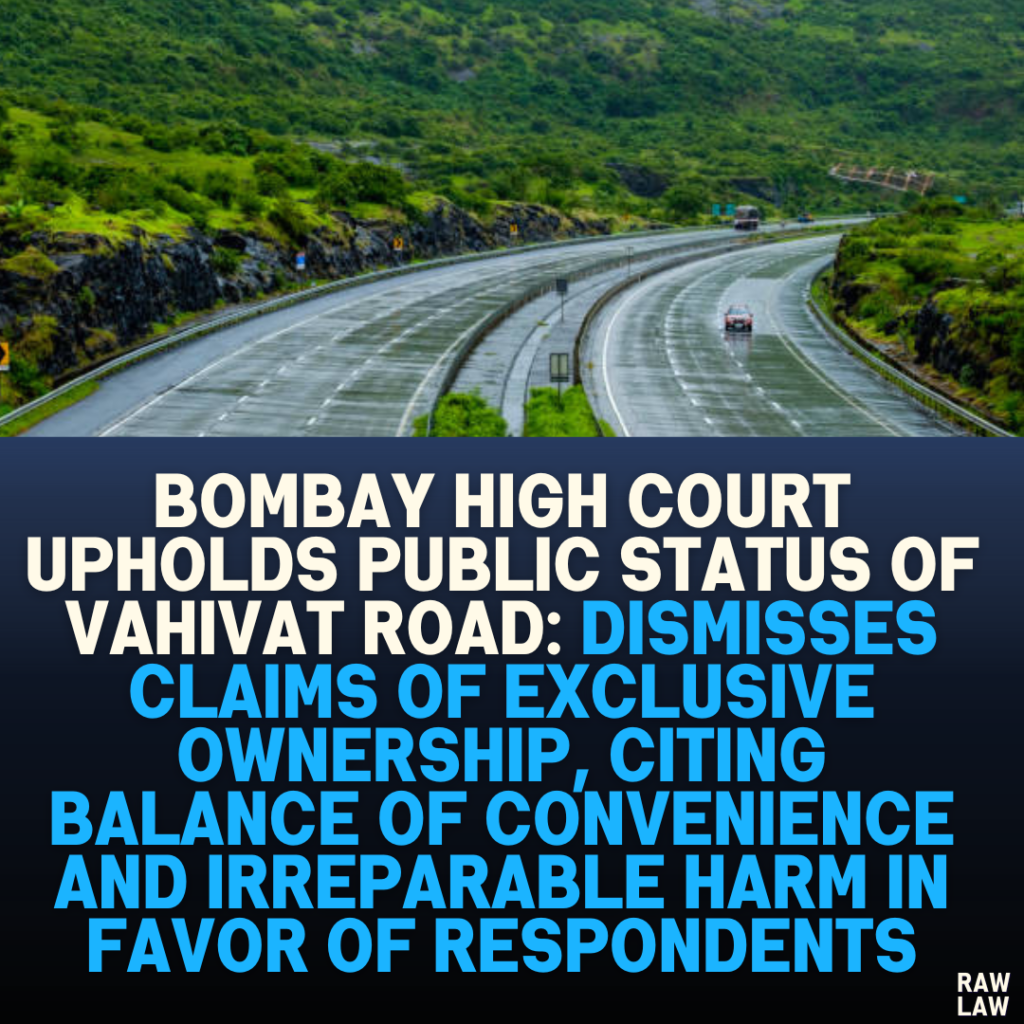Court’s Decision
The Bombay High Court dismissed two writ petitions challenging the District Court’s decision, which overturned an injunction granted by the Trial Court. The injunction had restrained the respondents from using or developing a vahivat road. The High Court upheld the District Court’s decision, finding that the road is a public thoroughfare as documented in Gram Panchayat records. The Court concluded that the respondents had a stronger prima facie case to use the road, as denying access would cause them irreparable harm, while sharing the road would not similarly harm the petitioners.
Facts
- Petitioners’ Ownership: The petitioners own agricultural plots (Gat Nos. 708-711) and claimed that a vahivat road running alongside their plots is their private road used for ingress and egress.
- Respondents’ Plots: The respondents own subdivided plots (Gat Nos. 720/1, 720/2, and 720/3), which also rely on the disputed road for access.
- Litigation Origin: The petitioners filed a civil suit in 2023 seeking an injunction to prevent the respondents from using or developing the road, claiming that granting non-agricultural (NA) permissions to the respondents would obstruct their access.
- Trial Court Injunction: The Trial Court granted an injunction favoring the petitioners.
- Appeals and Reversal: The respondents appealed to the District Court, which reversed the injunction, ruling that the road is public as evidenced by Gram Panchayat records and public funds used for maintenance.
Issues
- Is the disputed vahivat road a private road owned exclusively by the petitioners?
- Does the respondents’ use and development of the road infringe on the petitioners’ rights?
- Was the Trial Court’s grant of an injunction legally justified?
Petitioner’s Arguments
- Exclusive Use: The petitioners asserted that they have used the vahivat road exclusively for decades, establishing prescriptive rights.
- Private Road Status: They argued that the road is private, created and maintained by them for their agricultural and residential use.
- Obstruction of Access: Granting NA permissions to the respondents would obstruct their access to their plots.
- Trial Court Justification: The petitioners contended that the Trial Court correctly recognized their right to the road and issued an injunction.
Respondent’s Arguments
- Public Nature of the Road: The respondents emphasized that the vahivat road is classified as a public road in Gram Panchayat records and maintained with public funds.
- No Ownership by Petitioners: They argued that the petitioners have not established legal ownership of the road.
- Essential Access: Denying the respondents access to the road would render their plots landlocked, causing irreparable harm.
- NA Permissions: The respondents pointed out that permissions were granted after due consideration by the authorities, including site inspections and review of objections.
Analysis of the Law
- Ownership and Injunction Standards: Under established principles, an injunction can only be granted if the claimant establishes clear ownership or legal entitlement. In this case, the petitioners relied solely on prescriptive rights, which were insufficient to demonstrate exclusive ownership.
- Public Roads: Roads maintained with public funds and recorded in Gram Panchayat records as public cannot be claimed as private without definitive evidence.
- Balance of Convenience and Harm: Courts must weigh the impact of their decisions. Here, denying access to the respondents would cause significant harm, while allowing shared use of the road would not irreparably harm the petitioners.
Precedent Analysis
The Court applied established legal principles that emphasize the need for clear evidence of ownership in disputes involving public access roads. It also underscored the importance of balancing convenience and harm when granting or denying injunctions.
Court’s Reasoning
- Status of the Road: The Court noted that the vahivat road is recorded as a public road in Gram Panchayat records and has been maintained with public funds. This evidence outweighed the petitioners’ claims of exclusive ownership based on long use.
- Prima Facie Case: The respondents demonstrated a stronger prima facie case as denying them access would leave their plots landlocked.
- Petitioners’ Weak Case: The petitioners failed to produce sufficient evidence to prove ownership or legal entitlement to exclusive use of the road.
- Irreparable Harm and Balance of Convenience: The Court found that the balance of convenience and potential harm favored the respondents, as allowing shared use of the road would not irreparably harm the petitioners.
Conclusion
The High Court dismissed the writ petitions, affirming the District Court’s decision. It ruled that the road is a public thoroughfare and that the respondents have a right to use it until the final resolution of the trial.
Implications
- Public Access Roads: This judgment reinforces the principle that roads classified as public cannot be claimed as private without conclusive evidence.
- Prescriptive Rights: Long-term use alone is insufficient to establish ownership or exclusive rights to property, especially when public funds have been used for its maintenance.
- Balancing Interests: The decision highlights the judiciary’s role in balancing competing interests and preventing undue hardship in property disputes.
